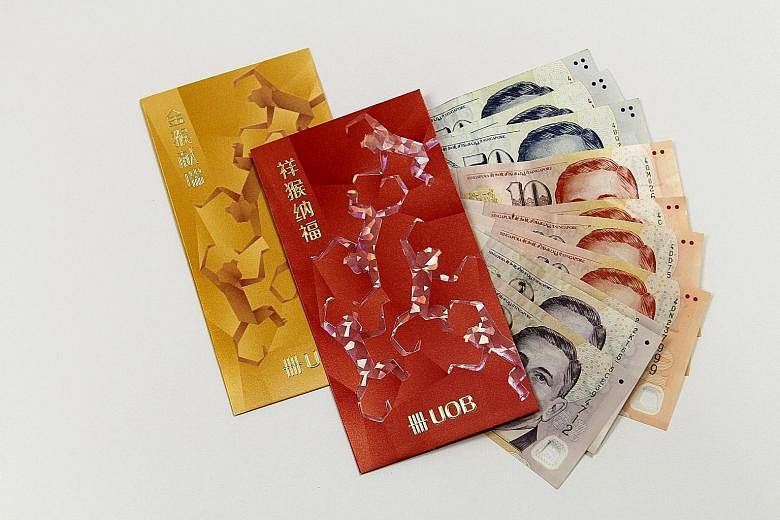Despite the bleak economic outlook, Singaporeans are not planning to cut back on their spending this Chinese New Year.
A street poll of 60 people by The Straits Times yesterday found the going rate for hongbao this year to be between $8 and $10, especially among the younger crowd.
Civil servant Joel Lim, 36, intends to hand out fatter hongbao for the Year of the Monkey, following a pay rise last year. He is giving $10 each to relatives and his friends' children, up from $8 last year.
"I am giving $2 more because financially I am able to give more," said Mr Lim. "I am also opening my new house in Punggol to my relatives for the first time this year, so I think it's appropriate to give more."
It is a tradition for married couples to give red packets - usually containing new notes - to their parents, single adults and children during Chinese New Year as tokens of good luck and blessing.
-
A United Overseas Bank survey, conducted by market research firm Ipsos last month, polled 503 people in Singapore aged between 25 and 55 about their plans for Chinese New Year. This is the average amount, per recipient, that respondents intend to hand out
PARENTS - $389
PARENTS-IN-LAW - $232
GRANDPARENTS $181
NIECES/NEPHEWS/OTHER RELATIVES' CHILDREN - $132
CHILDREN - $124
This year, the first day of Chinese New Year falls on Feb 8.
Some people, especially among the older generation, are sticking to auspicious-sounding amounts for their hongbao.
Retiree Leow Kian Huay, 69, plans to give $12 each to her grandchildren and $168 to her children.
"Twelve dollars is for good luck and to wish them a long life, while $168 is a wish for them to strike it rich this year," she said. In Cantonese, the number 168 sounds like "prosper all the way".
Store manager Alan Lee, 67, will hand out $6 red packets.
"Two dollars is too little and four is a bad number, so six is perfect," he said. In Mandarin, the number four sounds like "death".
Most baulked when asked if they will consider giving $2 hongbao.
"Two dollars? Might as well not give. It's not enough to buy anything, just tea or coffee," said Mr Alex Tay, 60, a real estate agent.
Mr Johnson Lin, a logistics manager who intends to follow the "market rate" and give between $8 and $18 per hongbao, said: "Two dollars was OK 30 years ago, but now, it's really too little."
But the 45-year-old added that the amount given should depend on a person's financial ability. "I understand that for those not well-to-do, $2 is just a token of their good wishes."
Almost all those polled said they will not consider giving electronic hongbao. This trend, in which money is sent and received through smartphones, is becoming more popular in China and sparked a digital battle among the country's Web giants last year.
Civil servant Janet Tan, 32, who is giving at least $8 per red packet this year, said she will not take up this option even if it saves her the hassle of having to queue up to get new notes at the bank.
"The act of giving red packets to the young is quite a symbolic gesture," she said. "I remember the joy of opening red packets after Chinese New Year. And, sometimes, the young adults use the cash they get to gamble a little (during house visits)."
Meanwhile, a separate survey by United Overseas Bank found that consumers intend to spend an average of $2,805 each this festive season, 20 per cent more than last year's budget of $2,345.
The increase was due to more respondents planning to travel over the festive period - 39 per cent this year against 32 per cent last year.
Market research firm Ipsos interviewed 503 people aged between 25 and 55 last month for the survey.

